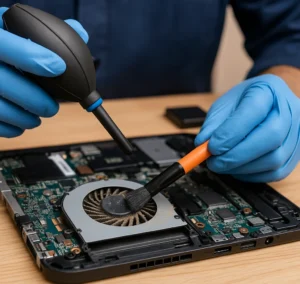If your gaming PC feels hotter, louder, or slower in 2025, you’re not alone. Newer titles push hardware hard, and small issues—dust, old drivers, cluttered storage—add up. Here’s a fast, safe tune-up plan you can do today to lower temps, reduce stutter, and extend the life of your parts.
1) Start with health checks (temps, clocks, fans)
Before changing anything, get a baseline. Use a trusted monitor (e.g., HWInfo) to watch CPU/GPU temperature, clock speeds, and fan RPM while gaming for 10–15 minutes. If CPU peaks above ~90 °C or GPU above ~85 °C, focus on cooling first.
- Download: HWInfo
- Internal help: Gaming PC Repair • PC Services • Contact
“Measure first, tweak second. Numbers tell you exactly where the bottleneck lives.”
2) Dust & airflow: free FPS hiding in your case
Shut down, unplug, and move the PC somewhere ventilated. Open the side panel. With short bursts from a can of compressed air, clear dust from filters, fans, GPU heatsink, CPU cooler, and PSU intake. Hold fan blades still with a finger to avoid overspinning.
3) Drivers, BIOS, and Windows tweaks (safe wins)
- GPU driver: Update via NVIDIA/AMD app. If problems started after an update, clean-install the previous known-good version.
- Chipset & BIOS: Install the latest chipset driver and a stable (not beta) BIOS for improved memory/IO stability.
- Background apps: Disable unnecessary auto-start apps; turn off overlays you don’t use.
- Power plan: Use Windows Balanced or High Performance for desktop rigs; avoid power-saving plans while gaming.
4) Storage hygiene: faster loads, fewer stutters
Keep at least 15–20% free space on your game SSD. Move old recordings and unused titles to a secondary drive. Run a quick file-system check and trim (Windows handles TRIM automatically on SSDs).
| Task | Time | Impact |
|---|---|---|
| Free 20% space on game SSD | 10–20 min | Smoother streaming & loads |
| Move recordings to HDD/NAS | 15–30 min | Prevents mid-match stutter |
| Remove launchers you don’t use | 5–10 min | Lower background CPU/RAM |
5) Thermal paste & pads (when temps are truly high)
If the CPU runs hot even after dusting and fan fixes, consider repasting. Good paste lasts years, but heavy use and high ambient temps can dry it out. For GPUs, only repaste/re-pad if you’re confident—the disassembly is trickier. Not comfortable? We can do it.
6) Smart settings inside games
Modern engines let you cap FPS, set a minimum frame-time budget, and scale heavy effects:
- Cap FPS just below your monitor’s refresh (e.g., 117 for 120 Hz) to reduce spikes and heat.
- Lower the big three first: Ray Tracing, Shadows, and Ambient Occlusion.
- Use DLSS/FSR/XeSS quality or balanced; start with quality for best visuals.
Mini-FAQ
Q: My GPU hits 86 °C in summer. Is that safe?
A: Brief spikes are okay, but aim for low-80s or less during sustained play. Improve case airflow, raise fan curves slightly, and clean dust.
Q: Should I undervolt?
A: A modest undervolt on modern GPUs can reduce 5–10 °C with minimal FPS loss. Follow a guide for your exact model.
Q: NVMe at 90% full—does it matter?
A: Yes. Keep 15–20% free on your game drive to prevent write-amplification, thermal throttling, and stutter.
Call us if you want it handled end-to-end
We clean, repaste, optimize, and stress-test gaming PCs every day in Garfield, NJ and nearby towns like Lodi and Elmwood Park. We’ll return your rig cooler, quieter, and faster—with proof (before/after temps and benchmarks).
Need help? Visit elitepcnj.com, email service@elitepcnj.com, or call 973-594-6105.


